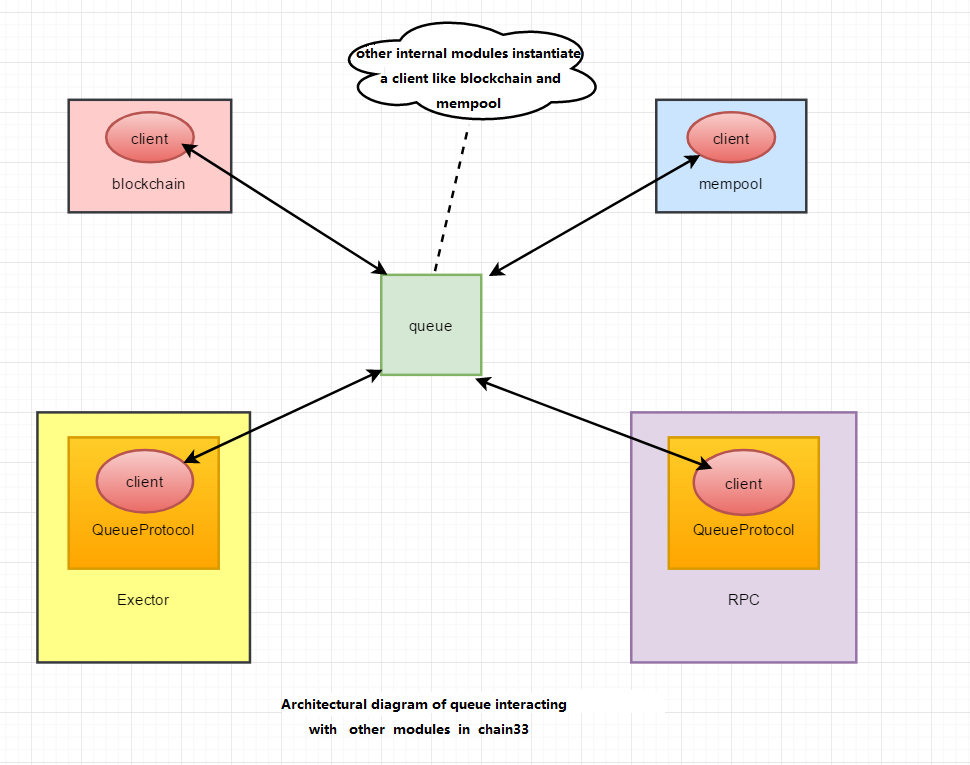-
Notifications
You must be signed in to change notification settings - Fork 255
queue模块
[TOC]
queue 顾名思义,这个模块实现了消息队列的功能。
主要目的是为了降低chain33系统中各个模块的耦合度,引入queue模块后,每个模块相对来说独立,模块之间通信不是通过接口调用,而是通过消息进行传递。这也方便我们日后按模块拆分chain33,为后面各个模块的微服务化做铺垫。
下图就是各模块与queue模块的关联关系

注意:
- 在我们chain33中,系统只实例化一个queue,每个模块都实例化了一个queue.client
- 一个queue可以对应多个订阅主题,也就是一个queue可以实例化多个queue.client
- 一个queue.client只能对应一个订阅主题。
- exector和rpc模块各自都额外实例化一个QueueProtocol
queue 中主要定义了三种数据结构,queue, client, Message
下面分别介绍他们的数据结构及相应的接口
queue这里的实现主要是利用go语言中channel的属性,利用缓存通道先进先出的特性来实现。定义了chanSub定义通道,一个订阅主题对应一个chanSub.
// queue数据结构
type queue struct {
chanSubs map[string]*chanSub // queue中订阅的通道 key=订阅名,value怎是订阅通道
mu sync.Mutex // 同步锁
done chan struct{} // 结束通知
interupt chan struct{} // 当程序被打断时,如linux中用ctrl+c结束运行程序,会触发interupt去关闭queue
isClose int32 // queue状态,1为关闭状态
name string // 队列名称
}queue接口比较简单,最主要的是client()这个方法,后面所有操作都是以client方式去执行 queue与client是一对多的关系。
// queue接口
type Queue interface {
Close() // 关闭queue
Start() // 启动
Client() Client // 获取queue的客户端,在chain33中,所有msg的 send和receive都通过client去调用
Name() string // 获取queue名称
}chanSub中我们根据channel缓存大小,设置了一个同步,和异步通道 同步通道中的数据处理优先级最高
// chanSub数据结构
type chanSub struct {
high chan Message // 同步处理通道,默认缓存大小64
low chan Message // 异步处理通道,默认缓存大小40960
isClose int32 // 订阅通道状态 1为关闭
}这里我们定义了msg,也巧妙地利用了channel属性, 将响应的数据通过chReply响应通道返回。
// Message数据结构
type Message struct {
Topic string // 主题,也就是给谁发送的
Ty int64 // 消息类型
Id int64 // 自增长的Id,在同一个queue中,每个msg有唯一的Id与之对应
Data interface{} // 消息数据
chReply chan Message // msg响应通道,用于返回接收方响应的数据,这里比较巧妙地利用了chan特有的属性
}queue中的所有msg的send,receive 都是通过client去发送
// Client数据结构
type client struct {
q *queue // queue实例
recv chan Message // 接收Msg通道,默认缓冲时是5
done chan struct{} // 用来通知client关闭
wg *sync.WaitGroup // 同步等待
topic string // 订阅主题
isClosed int32 // client状态,1为关闭
isCloseing int32 // 1表示client状态关闭
}client实现了如下方法,构造Msg,send,wait,Recv等
// Client接口
type Client interface {
Send(msg Message, waitReply bool) (err error) //发送消息,默认主网超时时间是10分钟
SendTimeout(msg Message, waitReply bool, timeout time.Duration) (err error) //发送消息,自定义超时时间
Wait(msg Message) (Message, error) //等待消息处理完成,默认主网超时时间是10分钟
WaitTimeout(msg Message, timeout time.Duration) (Message, error) //等待消息处理完成,自定义超时时间
Recv() chan Message //获取client接收消息通道
Sub(topic string) //订阅消息
Close() //关闭client
CloseQueue() (*types.Reply, error) //关闭queue
NewMessage(topic string, ty int64, data interface{}) (msg Message) //new 一个msg
}chain33中所有模块都实现了Module接口 其中SetQueueClient()方法主要功能是设置订阅主题,根据业务处理自己订阅的Msg并返回.
// Module be used for module interface
type Module interface {
SetQueueClient(client Client) //各个模块都会实现这个接口,在这里面会对相应的msg做具体的处理
Close()
}下面将结合chain33中的代码,以伪代码的形式给大家呈现整个流程
func main(){
......
log.Info("loading queue")
q := queue.New("channel") //实例化一个名为channel的queue
log.Info("loading blockchain module")
chain := blockchain.New(cfg.BlockChain)
chain.SetQueueClient(q.Client()) //将q.client()传入,SetQueueClient()是各个模块实际的处理逻辑
......
//jsonrpc, grpc, channel 三种模式
rpcapi := rpc.New(cfg.Rpc)
rpcapi.SetQueueClient(q.Client()) //给rpcapi赋值client
......
q.Start() //启动queue
}这里以blockchain模块为例,展示如何处理收到的msg
blockchain实现SetQueueClient方法
func (chain *BlockChain) SetQueueClient(client queue.Client) {
chain.client = client
chain.client.Sub("blockchain") //设置订阅主题,本client会只接收topic为blockchain的消息
......
go chain.ProcRecvMsg() //对接收到的消息做具体的处理
}blockchain对接收msg进行处理
//blockchain模块的消息接收处理
func (chain *BlockChain) ProcRecvMsg() {
defer chain.recvwg.Done()
reqnum := make(chan struct{}, 1000) //这里做了流量控制,最多同时处理1000条msg
for msg := range chain.client.Recv() { //从client中取msg
chainlog.Debug("blockchain recv", "msg", types.GetEventName(int(msg.Ty)), "id", msg.Id, "cap", len(reqnum))
msgtype := msg.Ty
reqnum <- struct{}{}
atomic.AddInt32(&chain.runcount, 1)
switch msgtype {
case types.EventLocalGet:
go chain.processMsg(msg, reqnum, chain.localGet) // blockchain中msg的通用处理方法
......
}
}processMsg方法处理逻辑,调用传入的func
// processMsg
func (chain *BlockChain) processMsg(msg queue.Message, reqnum chan struct{}, cb funcProcess) {
beg := types.Now()
defer func() {
<-reqnum
atomic.AddInt32(&chain.runcount, -1) //处理完一条msg,runcount计数器就减一
chainlog.Debug("process", "cost", types.Since(beg), "msg", types.GetEventName(int(msg.Ty)))
}()
cb(msg) //调用传过来的函数
}根据消息类型触发相应的func,这里是localGet方法
// localGet
func (chain *BlockChain) localGet(msg queue.Message) {
keys := (msg.Data).(*types.LocalDBGet)
values := chain.blockStore.Get(keys)
msg.Reply(chain.client.NewMessage("rpc", types.EventLocalReplyValue, values))
}返回处理后的结果
// Message中的Reply方法
func (msg Message) Reply(replyMsg Message) {
if msg.chReply == nil {
qlog.Debug("reply a empty chreply", "msg", msg)
return
}
msg.chReply <- replyMsg //就是将replyMsg塞给接收的msg的chReply通道
qlog.Debug("reply msg ok", "msg", msg)
}从上面我们可以知道msg的send和receive都需要通过queue的client 这在系统内部模块如block,mempool,consensus等,可以直接调用client.Send()方法就可以了,但是如果我是在系统外部,该如何调用呢?不急,我们先了解一下QueueProtocol
QueueProtocol数据结构,这里主要是对queue.client进行包装,无需设置订阅主题, 就可以和其他模块进行通信。
// QueueProtocol数据结构
type QueueProtocolOption struct {
// 发送请求超时时间
SendTimeout time.Duration
// 接收应答超时时间
WaitTimeout time.Duration
}
// 消息通道协议实现
type QueueProtocol struct {
// 消息队列
client queue.Client
option QueueProtocolOption
}聪明的你一定猜到怎么调用了。你想的没错,就是通过实例化QueueProtocol去调用 这里最终会实例化一个QueueProtocol对象,client.New(q.Client(), nil),jsonRPC和gRPC 共享这一个QueueProtocol
RPC模块实现SetQueueClient方法
// rpc 实现 Module接口
func (r *RPC) SetQueueClient(c queue.Client) {
gapi := NewGRpcServer(c)
japi := NewJSONRPCServer(c)
r.gapi = gapi
r.japi = japi
r.c = c
//注册系统rpc
pluginmgr.AddRPC(r)
go gapi.Listen()
go japi.Listen()
}执行器模块也实例化一个QueueProtocol
func (exec *Executor) SetQueueClient(qcli queue.Client) {
exec.client = qcli
exec.client.Sub("execs")
var err error
exec.qclient, err = client.New(qcli, nil) //执行器模块也实例化一个QueueProtocol
if err != nil {
panic(err)
}
//recv 消息的处理
go func() {
for msg := range exec.client.Recv() {
.....
}()
}QueueProtocolAPI中主要定义并实现了一些API方法,供其他模块调用,主要就是将 API方法传入的参数转化为相应的msg发送,接收并处理返回的msg,将msg再转化为 API方法所需的数据结构。
// 消息通道交互API接口定义
type QueueProtocolAPI interface {
......
// +++++++++++++++ consensus interfaces begin
// types.EventGetTicketCount
GetTicketCount() (*types.Int64, error)
// --------------- consensus interfaces end
// +++++++++++++++ wallet interfaces begin
// types.EventLocalGet
LocalGet(param *types.LocalDBGet) (*types.LocalReplyValue, error)
// types.EventLocalList
......
}这里以LocalGet()举例,展示如何将参数转化为msg处理
调用QueueProtocol中的LocalGet()方法,去触发往blockchain中发送types.EventLocalGet类型的 msg, LocalGet方法触发query方法
func (q *QueueProtocol) LocalGet(param *types.LocalDBGet) (*types.LocalReplyValue, error) {
......
msg, err := q.query(blockchainKey, types.EventLocalGet, param) //QueueProtocol模块通用的query方法
if err != nil {
log.Error("LocalGet", "Error", err.Error())
return nil, err
}
if reply, ok := msg.GetData().(*types.LocalReplyValue); ok {
return reply, nil
}
......
return nil, types.ErrTypeAsset
}query查询方法,就是将相关param包装成Msg,发送到对应的模块。
func (q *QueueProtocol) query(topic string, ty int64, data interface{}) (queue.Message, error) {
client := q.client
msg := client.NewMessage(topic, ty, data) //将相关参数转化为msg
var trace *tlog.TraceInfo
if tlog.TraceOn() {
if item, ok := data.(*types.Transaction); ok {
trace = tlog.CreateTraceMsg(msg.Id, ty, hex.EncodeToString(item.Hash()), tlog.MsgCreate, tlog.RpcKey, "query")
if trace != nil {
trace.Begin()
}
}
}
err := client.SendTimeout(msg, true, q.option.SendTimeout) //同步发送
if err != nil {
if trace != nil {
trace.Error(err)
}
return queue.Message{}, err
}
msg, errR := client.WaitTimeout(msg, q.option.WaitTimeout) //等待处msg处理完后响应
if trace != nil {
trace.UpdateState(tlog.MsgProcessed)
if errR != nil {
trace.Error(errR)
} else {
trace.End()
}
}
return msg, errR
}client中的waitTimeout方法,等待msg的响应结果
// client中 waitTimeout方法
func (client *client) WaitTimeout(msg Message, timeout time.Duration) (Message, error) {
if msg.chReply == nil {
return Message{}, errors.New("empty wait channel")
}
t := time.NewTimer(timeout)
defer t.Stop()
select {
case msg = <-msg.chReply: //对原有的msg进行重新赋值,值是从chReply响应通道中取的
return msg, msg.Err()
case <-client.done:
return Message{}, errors.New("client is closed")
case <-t.C:
return Message{}, types.ErrTimeout //如果超时则返回超时错误
}
}hello world